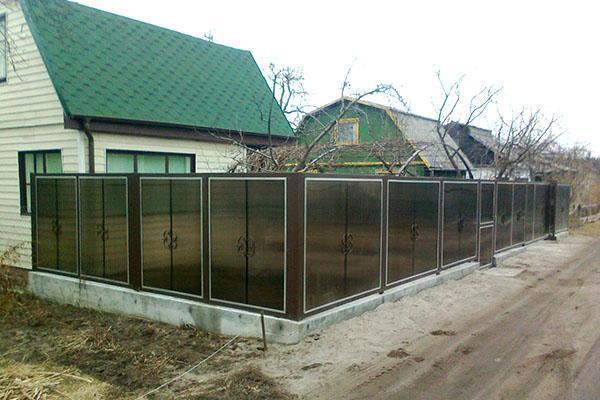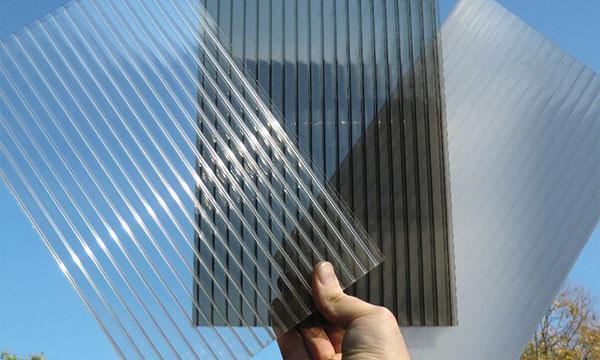Self-construction of a polycarbonate fence
 For the construction of fences in the arsenal of the developer there is a mass of reliable and proven materials over the years: wood, metal, brick, netting. Despite this, modern homeowners are increasingly paying attention to new types of fences, among which the polycarbonate fence is confidently taking the lead.
For the construction of fences in the arsenal of the developer there is a mass of reliable and proven materials over the years: wood, metal, brick, netting. Despite this, modern homeowners are increasingly paying attention to new types of fences, among which the polycarbonate fence is confidently taking the lead.

Main characteristics
 Polycarbonate is a synthetic polymer material produced in the form of sheets (panels) of various lengths from 3 to 12 m.The width of the panel, adopted by the standards, is 210 cm.In modern construction, two types of polycarbonate sheets are used:
Polycarbonate is a synthetic polymer material produced in the form of sheets (panels) of various lengths from 3 to 12 m.The width of the panel, adopted by the standards, is 210 cm.In modern construction, two types of polycarbonate sheets are used:
- Cellular. Has a cellular structure. The outer plates are interconnected by straight or X-shaped stiffeners. The length and thickness of the sheet varies depending on the type of material (3-40 mm).

- Monolithic. It is a transparent or translucent homogeneous material of increased strength. Thickness from 1 to 12 mm.

Structured (honeycomb) polycarbonate sheet is available in a wide variety of color variations, making it easy to choose for the implementation of any design solutions.
Advantages and Disadvantages of Synthetic Polymer
 The main advantages of the material include:
The main advantages of the material include:
- low weight, which does not require a powerful support frame;
- resistance to corrosion and external weathering;
- resistance to mechanical stress, the viscous structure of the material does not allow the polymer to crack from impact, polycarbonate is 200 times stronger than glass;
- good light transmission, transparent plastic transmits up to 90% of natural light;
- low thermal conductivity;
- chemical resistance;
- a wide range of operating temperatures, the polymer can be used at temperatures from - 50 to + 120 ° С without losing its performance;
- ease of care, which boils down to periodic washing with soapy water.
All these qualities make polycarbonate an excellent material for creating fences, greenhouses, sheds, covered structures, etc. Fences made of polycarbonate on a metal profile perform their main function quite well - protecting the site from unauthorized entry. Thanks to the honeycomb structure, they perfectly absorb street sounds, protecting the owners from noise.
The main disadvantage of polycarbonate, as, indeed, of all synthetic polymers, is destruction under the influence of UV radiation.
Given this fact, modern manufacturers cover this material with a special protective coating. In addition, the synthetic polymer has a fairly high coefficient of thermal expansion. That is why polycarbonate fences are made only in separate sections. A metal welded frame or brickwork is used as the supporting structure of such a fence.
Fence erection technology from sheet polycarbonate
 The process of erecting fences made of polymer sheet differs little from the technology of erecting fences from a profiled sheet and looks like this:
The process of erecting fences made of polymer sheet differs little from the technology of erecting fences from a profiled sheet and looks like this:
- perimeter markings;
- preparation of holes of appropriate depth and diameter;
- installation of support pillars;
- fastening to the transverse lag supports;
- installation of polycarbonate sheets.
To create external fences, it is preferable to use a monolithic sheet material that has high strength and the ability to bend without compromising characteristics. If you want to make a beautiful and transparent polycarbonate fence between neighbors in the country, then you can opt for a budget option - structured panels.
Material preparation
 For supports, a metal profiled pipe with a section of 60 x 60 mm and a wall thickness of 2 mm will be required. The length of the support pillars depends on the expected height of the fence, the depth of the laying and the method of fixing the supports in the ground.
For supports, a metal profiled pipe with a section of 60 x 60 mm and a wall thickness of 2 mm will be required. The length of the support pillars depends on the expected height of the fence, the depth of the laying and the method of fixing the supports in the ground.
For transverse logs, you must purchase a profile metal pipe with a section of 40 x 40 mm or 25 x 50 mm. Wall thickness is not less than 1 mm.
When choosing the thickness of the polymer sheet for fences, one should be guided by the distance between the jumpers. The optimal variant of the frame: three jumpers with a pitch of 600 - 1000 mm with a distance between the supports of 3 m. The minimum thickness of cellular polycarbonate is 8 mm.
In addition, you will need profiles for structured panels, the type of which should be selected depending on the thickness of the material, construction and fastening of the polycarbonate fence. A photo of possible varieties is clearly shown below.
If the support pillars will be concreted, then it is necessary to stock up on crushed stone, cement and sand to create a solution. We should not forget about the tool: drill; level, plumb line, tape measure, shovel, drill with a set of drills, screwdriver with a set of bits, grinder, welding machine and fasteners.
Stages of erection of a polycarbonate sheet fencing
 After preparing the material, you can proceed to the direct creation of a polycarbonate fence with your own hands.
After preparing the material, you can proceed to the direct creation of a polycarbonate fence with your own hands.
Stage number 1 - marking the perimeter of the site
 We determine the corner points of the fence and drive in the pegs, between which the cord should be pulled. Determine the mounting points for the support pillars. The recommended pitch is 3 m between the centers of future recesses.
We determine the corner points of the fence and drive in the pegs, between which the cord should be pulled. Determine the mounting points for the support pillars. The recommended pitch is 3 m between the centers of future recesses.
Stage number 2 - installation of support pillars
 We drill wells in the designated places. The average depth should not be less than 1/3 of the total length of the post.
We drill wells in the designated places. The average depth should not be less than 1/3 of the total length of the post.
When determining the depth of installation of supports, it is worth considering the indicators of the depth of soil freezing for a particular region. For heaving soils, the best option for fixing the supports would be a strip foundation with full reinforcement of the structure.
 We put a layer of sand or screenings at the bottom of each well. The thickness of the layer is 10-15 cm. We process the underground part of each support with bitumen or wrap it with roofing material to exclude the contact of metal with moisture. We install support posts in the prepared well, level it with a level and a plumb line, fix it with brick fragments, and concrete it. Depending on weather conditions and air temperature, the period of complete solidification of concrete varies from 23 to 30 days.
We put a layer of sand or screenings at the bottom of each well. The thickness of the layer is 10-15 cm. We process the underground part of each support with bitumen or wrap it with roofing material to exclude the contact of metal with moisture. We install support posts in the prepared well, level it with a level and a plumb line, fix it with brick fragments, and concrete it. Depending on weather conditions and air temperature, the period of complete solidification of concrete varies from 23 to 30 days.
Stage number 3 - creating the frame of the fence
 We weld horizontal jumpers (logs) to the support posts. The distance between the lags depends on the height of the polycarbonate fence. If the height of the fence is more than 1.5 m, then it is recommended to install three jumpers, with a distance of 60 to 100 cm between them.
We weld horizontal jumpers (logs) to the support posts. The distance between the lags depends on the height of the polycarbonate fence. If the height of the fence is more than 1.5 m, then it is recommended to install three jumpers, with a distance of 60 to 100 cm between them.
If it is not possible to use a welding machine to fix the jumpers, then it is quite acceptable to attach them to the racks using self-tapping screws for metal, installing the pipe on the "shelves" from a metal corner and fixing it carefully.
After erection of the structure, the frame is treated from rust, the seams are cleaned, and painted.
Stage 4 - fixing polycarbonate panels
 We mark and cut the material on the panel of the required size. For cutting, you can use a hacksaw with a fine tooth with minimal spreading or a jigsaw (setting the movement of the blade - without swinging). We put an end profile (UP) on the ends of each obtained workpiece. We drill holes at the points of attachment to the frame. The pitch between the holes is 300 mm.
We mark and cut the material on the panel of the required size. For cutting, you can use a hacksaw with a fine tooth with minimal spreading or a jigsaw (setting the movement of the blade - without swinging). We put an end profile (UP) on the ends of each obtained workpiece. We drill holes at the points of attachment to the frame. The pitch between the holes is 300 mm.
To reduce the risk of cracks in cellular polycarbonate, all attachment points should be made no closer than 40 mm from the edge of the material.
We should not forget about the thermal expansion of the honeycomb polymer, which can reach 10 mm in the direction of the air chambers. To avoid deformation of the fence, leave a thermal gap (5 mm) between the sheets. When expanding, cracks can also form at the attachment points. That is why it is recommended to use special thermal washers. The mounting structure is shown in the figure below.
In order to neutralize possible thermal expansion, you can fix the panels with honey through the connecting profile.
Taking into account the possible deformation of the material under temperature exposure, experts recommend using a welded frame from a corner for fixing polycarbonate, in which the material will be rigidly fixed only in the central part of each section. An example of such a design is shown in the photo.
The last step in self-erection of a polycarbonate fence is the release of the material from the transport film, which protected the panels from scratches and chips during the whole process. This completes the creation of the fence. The main thing is timely cleaning from dirt and regular checking of the integrity of the entire structure.